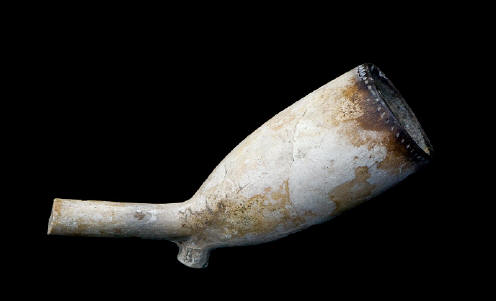American Colonial Artifacts
OLD CLAY TRADE PIPE
PIPE BOWL
DATES FROM ABOUT 1675...VERY EARLY EXAMPLE
 In
the 17th and 18th Centuries thousands of clay pipes came to the New World
and many fragments are still being
found in the soil of the earliest settlements. Pipe shards and intact
clays have been excavated on Civil War battlefields and in encampments in
great numbers showing the strong presence of clay pipes in the 1860s among
the soldiers who fought on both sides. "The Clay" remained king at least
among men until the later part of the 19th Century.
In
the 17th and 18th Centuries thousands of clay pipes came to the New World
and many fragments are still being
found in the soil of the earliest settlements. Pipe shards and intact
clays have been excavated on Civil War battlefields and in encampments in
great numbers showing the strong presence of clay pipes in the 1860s among
the soldiers who fought on both sides. "The Clay" remained king at least
among men until the later part of the 19th Century.
The first clay pipes were
introduced to Europeans along with tobacco smoking by the Native Americans
of South and North America. It was not long before clay pipe making became
an established trade. Later mass produced European and American clay
pipes became a trade item and were bartered back to Native American tribes.
Clay pipes were popular because they were disposable and easily replaced
when they broke (which happened quite a bit). A regular smoker might
break several in the course of a day’s puffing, but he could buy them by the
gross. Most tobacco "drinkers" preferred longer stems
and since they tended to break, they could be used until they were fairly
short, or had become "nose warmers" like this one. Because the
stems also became bitter with continued use, smokers would purposely break
off the end of the stem gradually working their way towards the bowl.
When they would get so close to the the bowl that it would become a nose
warmer they would throw the pipe away. This gave rise to the
expression "smoking to the bitter end".
This particular
trade pipe fits the profile of pipes made in the late 17th century.
Refinements were made so that the bowls became larger, up to 3/4 of an inch
inside and not as flat on the bottom. Clay pipe makers begin to add a milled
or plain ring at the top of the bowl with the maker's marks stamped
somewhere on the bowl. On this pipe you can barely see the makers stamp on
the heel. A shield with six stars.
The heel you often see on the bottom of a clay
pipe is not for resting it on a table or to hold with your fingers - it
helps clay pipe makers by adding extra material (or "bottom") to the pipe
when the stopper is used to make the bowl.
Clay pipes can be repaired
with the quill of a turkey or goose as a stem! Most of the information
above came from James E. Boyle & Beth Maxwell Boyle
Thistledown Croft